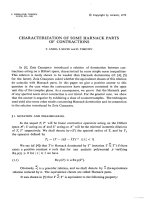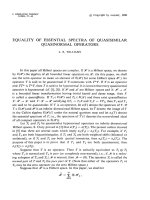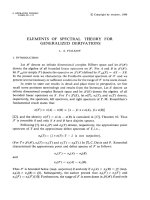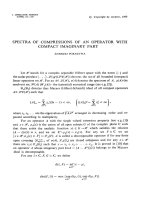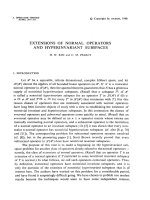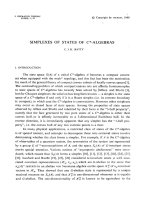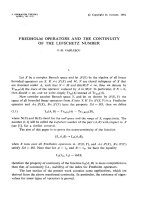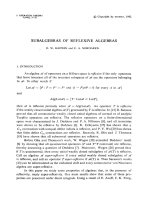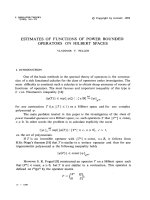Báo cáo toán học: " Generating of Minimal Unavoidable Sets" pps
Bạn đang xem bản rút gọn của tài liệu. Xem và tải ngay bản đầy đủ của tài liệu tại đây (150.44 KB, 14 trang )
Vietnam Journal of Mathematics 34:4 (2006) 459–472
Generating of Minimal Unavoidable Sets
Phan Trung Huy and Nguyen Thi Thanh Huyen
Department of Math., Hanoi University of Technology
1 Dai Co Viet Str., Hanoi, Vietnam
Dedicated to Professor Do Long Van on the occasion of his 65
th
birthday
Received August 28, 2006
Revised October 4, 2006
Abstract. In this paper we investigate several transformations on unavoidable sets
which preserve the minimality of such sets. The main result confirms that any minimal
unavoidable set over an alphabet
A can be obtained from A, regarded as the initial
manimal unavoidable set, by finitely many applications of such transformations. As a
consequence, a procedure to generate all possible minimal unavoidable sets over
A is
proposed. This allows in particular to generate easily counter-examples for both the
Ehrenfeucht’s conjecture and Haussler’s one on unavoidable sets.
2000 Mathematics Subject Classification: 68R15, 68S05
Keywords: Unavoidable set, transformation, reduced, minimal, generating, conjecture.
1. Introduction
In this section we recall some definitions and notations concerning with unavoid-
able sets and with two well-known conjectures on these sets: the Ehrenfeucht’s
conjecture and Haussler’s conjecture. For more background we refer to [2, 5].
All the alphabets considered in this paper are supposed to be finite. Given
an alphabet A,wedenotebyA
∗
the free monoid generated by A and we put
A
+
= A
∗
−{ε},whereε is the empty word. For any x, y ∈ A
∗
,wedenoteby
xy
−1
(resp. y
−1
x)thewordz satisfying the condition zy = x (resp. yz = x)if
it exists). Then, for any X, Y ⊆ A
∗
the right quotient of X by Y , denoted by
XY
−1
,isthesetofallxy
−1
with x ∈ X and y ∈ Y . The left quotient of X by
Y , denoted by Y
−1
X, is defined similarly.
Given X ⊆ A
∗
and u, w ∈ A
∗
.Wesaythatwwmeets u if w contains u as
460 Phan Trung Huy and Nguyen Thi Thanh Huyen
a factor, i.e. w = xuy for some x, y ∈ A
∗
.Wesaythatw avoids X if there does
not exist any u in X such that w meets u.
Definition 1.1. Given an alphabet A and X ⊆ A
+
. The set X is called an
unavoidable set over A if all words in A
∗
, except for a finite number of them,
have factors in X, or equivalently, if there exist only finitely many words avoiding
X, i.e. the set A
∗
− A
∗
XA
∗
is finite. A set X not being an unavoidable set is
called an avoidable set.
Given X ⊆ A
∗
, u ∈ X and u
= au or u
= ua for some a ∈ A. Then the set
X
= X −{u}∪{u
} is called an extention of X at u by a on the left or on the
right according as u
= au or u
= ua.Alsou
is called an extention of u by a
on the left or on the right according to the case.
Definition 1.2. Let X be an unavoidable set over an alphabet A, and |X| = n.
We say that
1) X is extendible if there exists an extention X
of X, X
= X −{u}∪{u
},
which is still an unavoidable set.
2) X is n-minimal (or simply minimal) if ∃u ∈ X such that X −{u} is still an
unavoidable set.
3) X is n-reductive (or simply reductive) if X is n-minimal and ∃u ∈ X such
that au
= u or u
a = u for some a ∈ A.
Example 1.1.
(1) X = { a
2
,ab,b
2
} is an unavoidable set over A = {a, b} because A
∗
−
A
∗
XA
∗
= {ε, a, b, ba} which is a finite set. It is easily verified that X is
a reduced unavoidable set.
(2) X = { a
3
,ab,b
2
} is an unavoidable set over A = {a, b} because A
∗
−
A
∗
XA
∗
= {ε, a, a
2
,b,ba,ba
2
}. It can be verified that X is a minimal but
not reduced unavoidable set.
(3) X = {a
3
,ab
2
,b
3
} is not an avoidable set because all the words of the form
w =(ab)
n
, the number of which is infinite, avoid X.
Remark 1.1. When replacing in X awordu by an extention u
of it, the
possibility of avoiding X for any word w does not decrease, and therefore the
possibility for X to be unavoidable does not increase.
Now we recall two well-known conjectures on unavoidable sets [3].
Ehrenfeucht’s conjecture
For every unavoidable set over an alphabet A, there exists always an exten-
sion X
of X which remains an unavoidable set over A. In other words, every
unavoidable set is extendible.
Haussler’s conjecture
For any reduced unavoidable set X over an alphabet A, the maximal word-
lenth of X must be smaller or equal to the cardinality | X| of X.
Generating of Minimal Unavoidable Sets 461
The following results are due to Choffrut and Culik II [1].
Proposition 1.1. Every unavoidable set contains a finite unavoidable set. In
particular, every minimal unavoidable sets is finite.
Theorem 1.1. The Ehrenfeucht’s conjecture is true if and only if it is true for
the case of two-letter alphabets.
In [6] Rosaz has constructed a counter-example for Ehrenfeucht’s conjec-
ture. In [4], by anather approach, namely by introducing and studying in deep
the sets S
X
(u, v) (see Definition 1.4), the authors have obtained some other
counter-examples for both Ehrenfeucht’s Conjecture. In this paper, we investi-
gate several transformations on unavoidable sets which preserve the minimality
of such sets. The main result confirms that any minimal unavoidable set over an
alphabet A can be obtained from A – the initial minimal unavoidable set – by
finitely many applications of such transformations. As a consequence, a proce-
dure to generate all possible minimal unavoidable sets over A is proposed. This
allows in particular to generate easily counter-examples for the Ehrenfeucht’s
and Hausler’s conjectures on unavoidable sets.
Convention: By Theorem 1.1, from now on we may restrict ourselves to con-
sider only the case of two-letter alphabets, namely A = {a, b}.
For any subset X ⊆ A
+
we say that
1. X is a prefix set if ∃u ∈ X : u = vx with v ∈ X, v = u and x ∈ A
∗
.
2. X is a suffix set if ∃u ∈ X : u = xv with v ∈ X, v = u and x ∈ A
∗
.
3. X is an infix set if ∃u ∈ X : u = xv with v ∈ X, v = u and x, y ∈ A
∗
.
4. X is a bifix set if X is suffix and prefix.
Definition 1.3.
1) Foru,v,winA
∗
,ifw = ux = yv for some x, y ∈ A
∗
,xy= ε,thenwis
called a u-v arrow.
2) For any u-u arrow w, we define w
n
= w.(w
)
n
,wherew
= u
−1
w, n ≥ 1
(Figure 1).
3) For any u-v arrow w, we say that w avoids X if w/∈ A
+
XA
+
.
4) For any u-v arrow w, we say that w is X-atomic if w avoids X ∪{u, v}.
Fig. 1. Definition of u-u arrow w
n
basing on u-u arrow w
Lemma 1.1. Let X be an infix set and u ∈ X. Then, the existence of a X-
atomic u-u arrow implies the existence of arbitrarily long u-u arrows avoiding
X −{u}.
462 Phan Trung Huy and Nguyen Thi Thanh Huyen
Proof. Let W be a X-atomic u-u arrow. Let us consider a u-u arrow w
n
=
w.(w
)
n
,wherew
= u
−1
w. Because w avoids X and X is infix, w
n
avoids
X −{u}.Withn large enough, w
n
is the u-u arrow required.
Lemma 1.2. Let X be an unavoidable set. Let u ∈ X and u is not redundant,
i.e. X −{u} is not an unavoidable set. Then for all words w, if w is long enough
and w avoids X −{u} then w meets u.
Proof. Because u is not redundant, X −{u} is an avoidable set. This means that
there are infinitely many words avoiding X −{u}. Among such words there are
only finitely many words avoiding u,otherwiseX is no more an unavoidable set,
that contradicts the hypothesis. Thus, if w is long enough and avoids X −{u}
then w must meet u.
Consequence 1.1. For each minimal unavoidable set X, there exists a natural
number N
0
such that for all w ∈ A
+
with |w|≥N
0
,ifw/∈ A
∗
(X −{u})A
∗
then
w ∈ A
∗
uA
∗
for any u in X.
Definition 1.4. LetXbeasubsetofA
∗
. For each pair of words u, v in X, we
associate a set S
X
(u, v) consisting of all X-atomic u-v arrows:
S
X
(u, v)=uA
+
∩ A
+
v − A
+
XA
+
which we write simply S(u, v) when no confusion may arise.
Proposition 1.2. Let X ⊆ A
+
, be an unavoidable set. X is minimal if and
only if hold the following conditions:
(i) X is an infix set.
(ii) For al l u ∈ X, S(u, u) = ∅.
Proof. (⇒) Suppose X is minimal, n = | X|. We will prove that the conditions
(i) and (ii) must be satisfied.
(i) If the condition (i) does not hold then there exist two words u, v ∈ X such
that u is a proper factor of v.ThenX −{v} is also an unavoidable set, which
contradicts the minimality of X. Thus (i) must hold.
(ii) Now assume that the condition (ii) does not hold, i.e. there exists u in X
such that S(u, u)=∅. Because X is a minimal unavoidable set, by Consequence
1.1, there exists N
0
such that for any w ∈ A
+
,if|w|≥N
0
and w avoids X −{u}
then w meets u.Letw be such a word. Consider the word w
2
= w.w. Because
w contains at least one u as factor and w avoids X −{u},fromw
2
we can always
extract a u-u arrow that is X-atomic. This means S(u, u) = ∅, a contradiction.
Thus (ii) must be hold.
(⇐)LetX be an infix set and S(u, u) = ∅ for all u ∈ X.SinceS(u, u) = ∅,
there exists a u-u arrow w which is X-atomic. By Lemma 1.1, there exists
arbitrarily long u-u one which avoids X −{u}. This means that, for any u in
X, X −{u} is not an unavoidable set. Thus X is a minimal unavoidable set.
In fact, Proposition 1.2 is a part of the following result proved in [4] in
another way.
Generating of Minimal Unavoidable Sets 463
Theorem 1.2. [4] A set X is unavoidable set if and only if the set S(u, v) is
finite for any u, v in X, and the unavoidable set X is minimal if and only if X
is an infix set and S(u, u) is not empty for all u in X.
2. Generating Minimal Unavoidable Sets
In this section we introduce and consider transformations on unavoidable sets
which preserve the minimality, and show that every minimal unavoidable set over
the alphabet A = {a, b} can be obtained from A, regarded as the initial minimal
unavoidable set, by a finite number of applications of such transformations.
First we introduce a label-assigning function, denoted by Asg, which assigns
to every word u in an unavoidable set X apair(l
u
,r
u
) of labels called the left
and the right label of u respectively.
Definition 2.1. Let X be a minimal unavoidable set on the alphabet A = {a, b}.
For every word u in X, Asg
X
(u)=(l
u
,r
u
) is defined as follows, where S stands
for S(u, u).
+ If suffix(S) ∩ Au = { au, bu} then l
u
=Lab.
+ If suffix(S) ∩ Au = { au} and |S(u, u)| =1then l
u
=Lia.
+ If suffix(S) ∩ Au = { bu} and |S(u, u)| =1then l
u
=Lib.
+ If suffix(S) ∩ Au = { au} and |S(u, u)| > 1 then l
u
=La.
+ If suffix(S) ∩ Au = { bu} and |S(u, u)| > 1 then l
u
=Lb.
+ If prefix(S) ∩ uA = {ua, ub} then r
u
=Rab.
+ If prefix(S) ∩ uA = {ua} and |S(u, u)| =1then r
u
=Ria.
+ If prefix(S) ∩ uA = {ub} and |S(u, u)| =1then r
u
=Rib.
+ If prefix(S) ∩ uA = {ua} and |S(u, u)| > 1 then r
u
=Ra.
+ If prefix(S) ∩ uA = {ub} and |S(u, u)| > 1 then r
u
=Rb.
The main result of this section is the following:
Theorem 2.1. Let X be a minimal unavoidable set, where n = |X|.Letu ∈ X,
and Asg
X
(u)=(l
u
,r
u
).
(a) If l
u
= Lab, then X can not be extended at u on the left to get a new
n-minimal unavoidable set, although the set X
= X −{u}∪{au, bu} is also
an (n+1)-minimal unavoidable set.
(b) If l
u
= Lia, then X can be extended consecutively on the left, beginning at
u by the letter a and then by appropriate letters, to obtain infinitely many
new n-minimal unavoidable sets. Similarly for the case l
u
= Lib.
(c) If l
u
= La, then X can be extended consecutively on the left only finitely
many times, beginning at u by the letter a and then by appropriate letters,
to obtain n-minimal unavoidable sets. Similarly for the case l
u
= Lb.
(d) If r
u
= Rab, then X can not be extended at u on the right to obtain a new
n-minimal unavoidable set, although the set X
= X −{u}∪{au, bu} is also
an (n+1)-minimal unavoidable set.
464 Phan Trung Huy and Nguyen Thi Thanh Huyen
(e) If r
u
= Ria, then X can be extended consecutively on the right, beginning at
u by the letter a and then by appropriate letters, to obtain infinitely many
new n-minimal unavoidable sets. Similarly for the case r
u
= Rib.
(f) If r
u
= Ra, then X can be extended consecutively on the right only finitely
many times, beginning at u by the letter a and then by appropriate letters,
to obtain new n-minimal unavoidable sets. Similarly for the case r
u
= Rb.
Proof. (a) A u-u arrows w is said to be of a-form if w = uy = xau with
x ∈ A
∗
, y ∈ A
∗
, a ∈ A. Arrows of b-form are defined similarly. By Proposition
1.2, S(u, u) = ∅ for all u ∈ X. Because l
u
= Lab, by Definition 2.1, we have
suffix(S) ∩ Au = {au, bu}. This means that S(u, u)containsu-u arrows of both
a-form and b-form. We consider two possibilities:
+ Extending X at u by the letter a on the left: X
= X −{u}∪{au}.Choose
in S(u, u)au-u arrow w of b-form. Consider an arrow w
n
with n large enough.
Because w is X-atomic, w avoids X −{u}. It follows from the minimality of X
that X is an infix set. Hence, by Lemma 1.1, the u-u arrows w
n
avoid X −{u}.
Because w is X-atomic and w is of b-form, w
n
avoids au.Thusw
n
avoids X
,
therefore X
is an unavoidable set.
+ Extending X at u by the letter b on the left X
= X −{u}∪{bu}.Ina
similar way we can prove that X
is not an unavoidable.
Thus, X can not be extended on the left to obtain a new n-minimal unavoid-
able set.
Now we prove that set X
= X −{u}∪{au}∪{bu} is a (n+1)-minimal
unavoidable set. Obviously, every word long enough which avoids both au and
bu also avoids u (note that the alphabet A consists of only two letters a and b).
Therefore X
is also an unavoidable set. Now we prove that X
is n+1-minimal.
Since S
X
(u, u) = ∅ and suffix(S) ∩ Au = {au, bu},wehaveS
X
(au, au) = ∅
and S
X
(bu, bu) = ∅. Because X is a minimal unavoidable set, it follows by
Proposition 1.2 that, S
X
(v, v) = ∅, for all v ∈ X, v = u. It is easily seen that
all the words avoiding u also avoid au and bu. This implies that all the words
avoiding X also avoid X
. Hence ∅ = S
X
(v, v) ⊆ S
X
(v, v). Thus, for all x ∈ X
,
S
X
(x, x) = ∅. From Proposition 1.2. it follows that X
is n+1-minimal.
(b) Let X
= X −{u}∪{au}. We shall prove that X
is n-minimal unavoid-
able set.
Indeed, by Consequence 1.1, ∃N
0
: ∀w ∈ A
+
, |w|≥N
0
,ifw avoids X −{u}
then w meets u. Consider an arbitrary word v avoiding X −{u} with |v|≥2N
0
,
we have v = v
1
v
2
,where|v
1
|, |v
2
|≥N
0
.Sincev, v
1
,v
2
meet u and avoid X−{u},
there is a factor w of v which belongs to S
X
(u, u). Because au is a suffix of w,
v meets au.Thus,X
is unavoidable. Since X is minimal, there are infinitely
many words v with |v|≥N
0
which avoid X −{u} and do not avoid u.Now,if
|v|≥2N
0
then v avoids X −{u} and v meets au.TherforeX
is minimal.
Since S
X
(u, u) consists of only one word w, whose suffix is au, S
X
(au, au)
has the same form, namely |S
X
(u, u)| =1andsuffix(S
X
(u, u)) ∩ Au = {pu} for
p = a or p = b. Hence X
=X
−{au}∪{pau} is also n-minimal. Continuing
this argument we can confirm that X can be infinitely extended on the left at u
with the letter a at the first step.
Generating of Minimal Unavoidable Sets 465
The proof of (c), (d), (e), (f) are similar.
We consider now some basic transformations on any finite set X ⊂ A
∗
.
LetusnotethatifS
X
(u, u)=∅ then u is redundant in X and we can delete
it.
Now we consider the following transformations on an unavoidable set X.
+ Left extension by a, denoted La: transforming X into X
= X−{u}∪{au},
for some u in X with l
u
= La or l
u
= Lia. The transformation Lb is defined
similarly.
+ Right extension by a, denoted Ra: transforming X into X
= X −{u}∪
{ua},forsomeu in X with r
u
= Ra or r
u
= Ria. The transformation Lb is
defined in a similarly way.
+ Left extension by a, b, denoted Lab: transforming X into X
= X −{u}∪
{au, bu},forsomeu in X with l
u
= Lab.
+ Right extension by a, b, denoted Rab: transforming X into X
= X −
{u}∪{ua, ub},forsomeu in X with r
u
= Rab.
+ Left cutting, denote LC: transforming X into X
,whereX
is obtained
from X −{u}∪{u
} with u
= A
−1
u, by deleting all words in it which contain
u
as a proper factor.
+ Right cutting, denote RC: transforming X into X
,whereX
is obtained
from X −{u}∪{u
} with u
= uA
−1
, by deleting all words in it which contain
u
as a proper factor.
+ Deletion, denote by D: transforming X into X
,whereX
is obtained
from X by deleting consecutively all redundant words in X.
For brevity, the transformations La, Lb, Lab,(Ra, Rb, Rab) are called com-
monly transformation L (transformation R, respectively).
As a direct consequence of Theorem 2.1 we obtain
Consequence 2.1. Applying transformation L and R on minimal unavoidable
sets leads to minimal unavoidable sets again.
The proofs of the following lemmas are easy and therefore omitted.
Lemma 2.1. Applying the transformations LC, RC and D on unavoidable sets
lead to unavoidable sets again.
Lemma 2.2. The initial unavoidable set A = {a, b} can be obtained from any
finite unavoidable set by finitely many applications of the transformations LC,
RC and D.
Lemma 2.3. Let X and Y be minimal unavoidable sets such that Y = X −
{u}∪{u
}, where u is a proper factor of u
.ThenYcanbeobtainedfromXby
a finite number of applications of the transformations L and R.
The following lemma is somewhat more complex and need some verification.
Lemma 2.4. Let X be a minimal unavoidable set. If Y can be obtained from X
by applying first some transformation RC or LC, and then some transformation
466 Phan Trung Huy and Nguyen Thi Thanh Huyen
D, then X can be obtained from Y by a finite number of applications of the
transformations L, R, LC, RC and D.
Proof. In the case |X| = |Y | the assertion is true by Lemma 2.3. So we treat
only the case |X| > |Y |. By duality, it suffices to check only the case applying
RC on some word x in X. Without loss of generality we may assume x = ua.
When the first transformation is RC, by applying RC we get u ∈ Y .Byusing
lemmas above, the following facts can be verified step by step:
+ The right label of u in Y is Rab
+ Each element deleted from X to get Y must be appeared in some ub-ub
arrow avoiding Y .
+Eachu-u arrow avoiding Y −{u} has to meet some deleted element in
Z = X − Y .
+ For any x in Z, each long enough x-x arrow avoiding Y ∪{ua} has to meet
ub.
+ By applying the extension Rab on Y at u in Y ,wegetX
, X
= Y −
{u}∪{ua, ub}, and then by other transformations R and L we can obtain a new
minimal unavoidable set Y
so that every deleted element x in Z is a factor of
some ub-ub arrow in Y
, |Y
|≥|X|.
+ Y
can be also obtained from X by applying some transformations R and
L.
+ Applying transformations RC, LC, D on Y
first at ub-ub arrows and then
at factors of them we can get X.
Now the following main result of this section can be easily proved basing on
the above mentioned lemmas.
Theorem 2.2. Every minimal unavoidable set over the alphabet A = {a, b} can
be obtained from the initial minimal unavoidable set A by taking finitely many
transformations R, L, LC, RC and D.
It is not difficult to see that the result remains valid for any finite alphabet.
Consequence 2.2. Every minimal unavoidable set over any finite alphabet A
can be obtained from the initial minimal unavoidable set A by applying finitely
many transformations R, L, LC, RC and D.
3. Generating of Counter-examples for Ehrenfeucht’s and Haussler’s
Conjectures
Now we present a computer computer program generating finite minimal un-
avoidable set starting from the alphabet A. This allows to find out easily counter-
examples for Ehrenfeucht’s and Haussler’s conjectures in one or two hours. The
correctness of the procedure can be verified directly basing on Theorem 2.2.
Procedure 3.1. (interactive mode)
1. Input any minimal unavoidable set, say X
0
;
Generating of Minimal Unavoidable Sets 467
2. X = X
0
;
3. Calculating Asg
X
(u) for all u in X;
4. exitOK=0;
5. While exitOK=0 do
6. Begin
a) SelectOne(Transformation);
b) Case Transformation of
L
k
: taking one left extension step of type L on x
k
in X;
R
k
: taking one right extension step of type R on x
k
in X;
LC
k
: cutting one letter on the left of x
k
in X by an action of type LC
k
;
RC
k
: cutting one letter on the right of x
k
in X by an action of type RC
k
;
D
k
: deleting x
k
in X; { whenever x
k
is redundant };
Write: Save list X to a file;
Copy: Copy list X to a buffer to re-use later if needed;
Exit: exitOK=1;
EndCase;
7. EndWhile;
8. EndProc;
We exhibit below some counter-examples for Ehrenfeucht’s and Haussler’s
conjectures, which have been obtained with the aid of Precedure 3.1.
Example 3.1. Counter-examples for Haussler’s conjecture:
X
n
= {aa, bbb, (ab)
n
a, (ab)
n
b, bbabb, bba(ba)bb, , bba(ba)
n-2
bb}, n =2, 3,
Generating X
2
is presented in Table 3.1.
Remark that the maximal wordlength of X
n
is 2n +1whichismuchlarger
than n = |X|. In [4] it is showed that there are infinitely many reduced unavoid-
able sets X whose maximal wordlength is of the size O(c
n
), where c>1isa
constant.
Table 3.1. Generating counter-example for Haussler Conjecture
from A = {a, b}
Step Left Right Unavoidable Next
label label sets operation
1 Lia Ria a R1
Lib Rib b
2 Lia Ria aa
Lab Rab b R2
3 Lia Ria aa
Lia Rib ba
Lib Rib bb R3
4 Lia Ria aa
Lab Rb ba R2
Lib Rib bbb
468 Phan Trung Huy and Nguyen Thi Thanh Huyen
Step Left Right Unavoidable Next
label label sets operation
5 Lab Rab aa
Lab Rab bab L2
Lib Rib bbb
6 Lab Rab aa
Lib Ria abab R2
Lia Rib bbab
Lib Rib bbb
7 Lab Rab aa
Lib Rib ababa R2
La Rab bbab
Lib Rib bbb
8 Lab Rab aa
Lib Ria ababab
La Rab bbab R3
Lib Rib bbb
9 Lab Rab aa
Lib Ria ababab
Lia Rib bbaba R3
Lia Ria bbabb
Lib Rib bbb
10 Lab Rab aa
Lib Ria ababab
Lia Rib bbabab R3
Lia Ria bbabb
Lib Rib bbb
11 Lab Rab aa
Lb Rab ababab R2
Lia Ria bbababb
Lia Ria bbabb
Lib Rib bbb
12 Lab Rab aa
Lib Rib abababa
Lib Ria abababb
Lia Ria bbababb
Lia Ria bbabb
Lib Rib bbb
Example 3.2. Counter-examples for Ehrenfeucht’s conjecture:
a) X = {a
3
,b
4
,ab
3
ab, ab
2
ab, abab, b
2
a
2
b
2
,ba
2
ba
2
b}
(see Table 3.2). This counter-examples has been obtained first by Rozas [6].
Generating of Minimal Unavoidable Sets 469
b) X = {a
4
,b
4
,ba
3
b, ba
2
ba
2
b, baba, b
2
a
2
b
2
,bab
2
a, bab
3
a},
c) X = {a
3
,b
4
,a
2
ba
2
b, baba, b
2
a
2
b
2
,bab
2
a, bab
3
a}
Table 3.2. Generating counter-example for Ehrenfeut conjecture
from {a, b}
Step Left Right Unavoidable Next
label label sets operation
1 Lia Ria a R1
Lib Rib b
2 Lia Ria aa
Lab Rab b L2
3 Lia Ria aaa
Lab Ra ab
Lib Rib bb R3
4 Lia Ria aaa
Lab Rab ab
Lib Rib bbb R3
5 Lia Ria aaa
Lab Rab ab R2
Lib Rib bbbb
6 Lia Ria aaa
Lab Rab aba R2
Lab Rab abb
Lib Rib bbbb
7 Lia Ria aaa
Lia Rib abaa
Lib Ria abab
Lab Rab abb R4
Lib Rib bbbb
8 Lia Ria aaa
Lia Rib abaa
Lib Ria abab
Lab Rab abba
Lab Ra abbb R5
Lib Rib bbbb
9 Lia Ria aaa
Lia Rib abaa
Lib Ria abab
Lab Rab abba R4
Lab Rab abbba
Lab Rab bbbb
470 Phan Trung Huy and Nguyen Thi Thanh Huyen
Step Left Right Unavoidable Next
label label sets operation
10 Lia Ria aaa
Lia Rib abaa
Lib Ria abab
Lia Rib abbaa R4
Lib Rib abbab
Lab Rab abbba
Lab Rab bbbb
11 Lab Rab aaa
Lia Rib abaa R2
Lib Ria abab
Lia Rib abbaab
Lib Rib abbab
Lab Rab abbba
Lab Rab bbbb
12 Lab Rab aaa
Lia Ria abaab L2
Lib Ria abab
Lia Rib abbaab
Lib Rib abbab
Lab Rab abbba
Lab Rab bbbb
13 Lab Rab aaa
Lib Ria aabaab
Lab Ra abab
Lia Rib abbaab
Lab Rab abbab
Lab Rab abbba R6
Lab Rab bbbb
14 Lab Rab aaa
Lia Rib baabaab
Lab Ra abab
Lia Rib abbaab LC4
Lab Rab abbab
Lab Rab abbba
Lab Rab bbbb
15 Lab Rab aaa
Lia Ria baabaab
Lab Ra abab
Lia Rib bbaab
Lab Rab abbab
Lab Rb abbba R6
Lab Rab bbbb
Generating of Minimal Unavoidable Sets 471
Step Left Right Unavoidable Next
label label sets operation
16 Lia Ria aaa
Lib Rib aabaa R2
Lab Ra abab
Lab Rb bbaa
Lab Rab abbab
Lab Rab abbbab
Lab Rab bbbb
17 Lab Rab aaa
Lib Ria aabaab L2
Lab Ra abab
Lab Rb bbaa
Lab Rab abbab
Lab Rab abbbab
Lab Rab bbbb
18 Lab Rab aaa
Lia Ria baabaab
Lab Ra abab
Lab Rb bbaa R4
Lab Rab abbab
Lab Rab abbbab
Lab Rab bbbb
19 Lab Rab aaa
Lia Ria baabaab
Lab Ra abab
Lab Rb bbaab R4
Lab Rab abbab
Lab Rab abbbab
Lab Rab bbbb
20 Lab Rab aaa
Lab Rab baabaab
Lab Rab abab
Lab Rab bbaabb
Lab Rab abbab
Lab Rab abbbab
Lab Rab bbbb
Acknowledgements. The authors would like to thank the referee for many helpful
commands which help us to improve the presentation of the paper more better
than before.
472 Phan Trung Huy and Nguyen Thi Thanh Huyen
References
1. Ch. Choffrut and K. Culik II, On extendibility of unavoidable sets, Discrete Appl.
Math. 9 (1984) 125–137.
2. S. Eilenberg, Automata, Languages and Machines, Vol. A (1974), Vol. B. (1976).
Acad. Press. NewYork.
3. A. Ehrenfeucht, D. Haussler, and G. Rozenberg, On regularity of context-free
languages, Theoret. Comput. Sci. 27 (1983) 311–332.
4. Phan Trung Huy and Nguyen Huong Lam, Unavoidable sets: Extension and re-
duction, Theoretical Informatics and Applications 33 (1999) 213–225.
5. M. Lothaire, Algebraic Combinatorics on Words, Cambridge University Press,
ISBN 0521812208, 2002.
6. L. Rosaz, Inventories of unavoidable languages and the words-extension conjecture,
Theor. Comput. Sci. 201 (1-2) (1998) 151–170.

